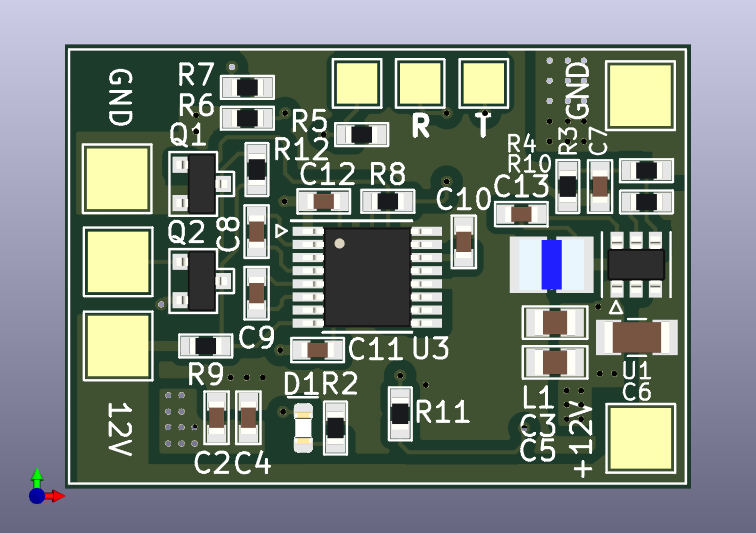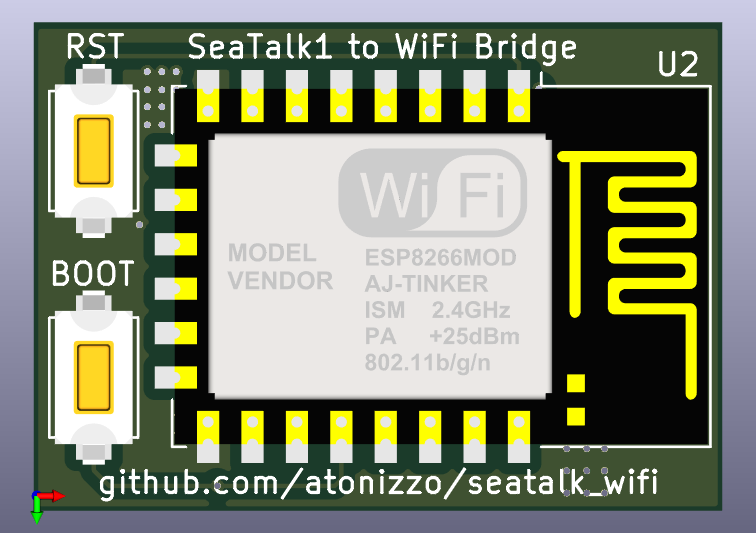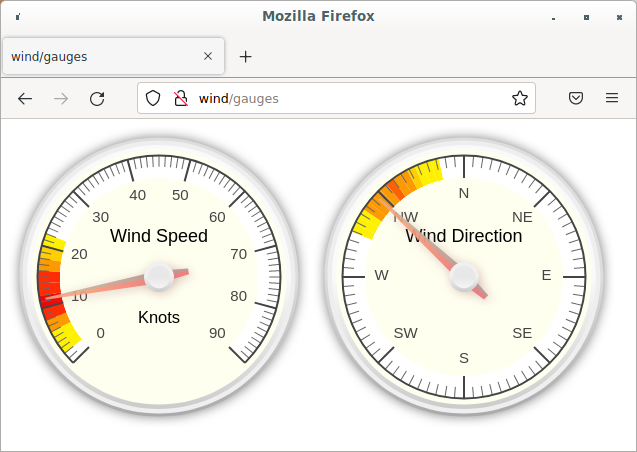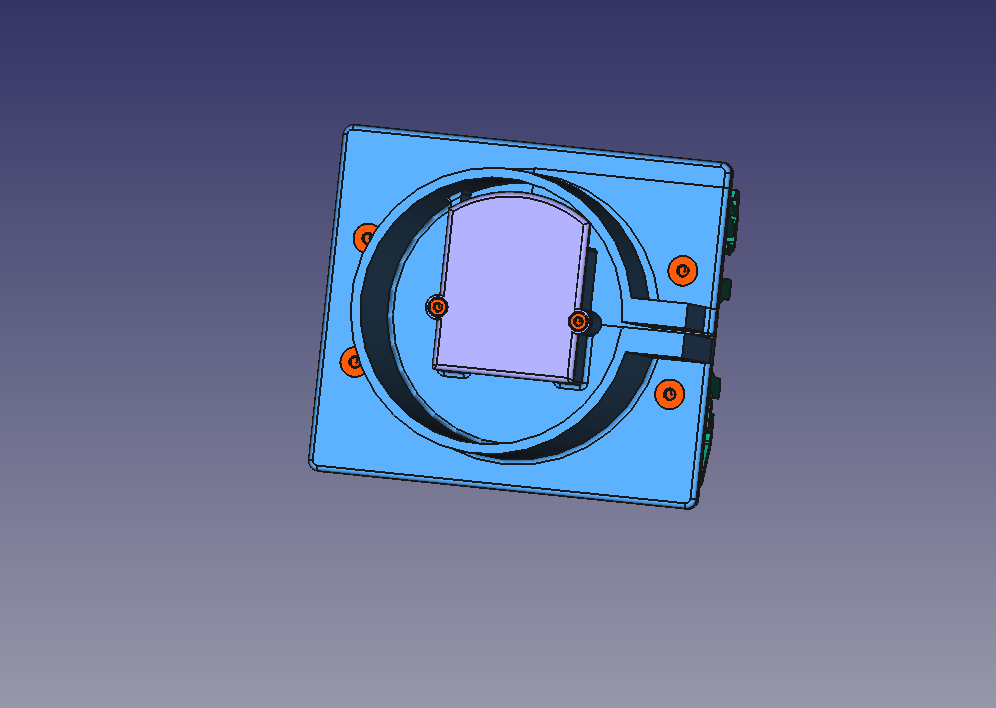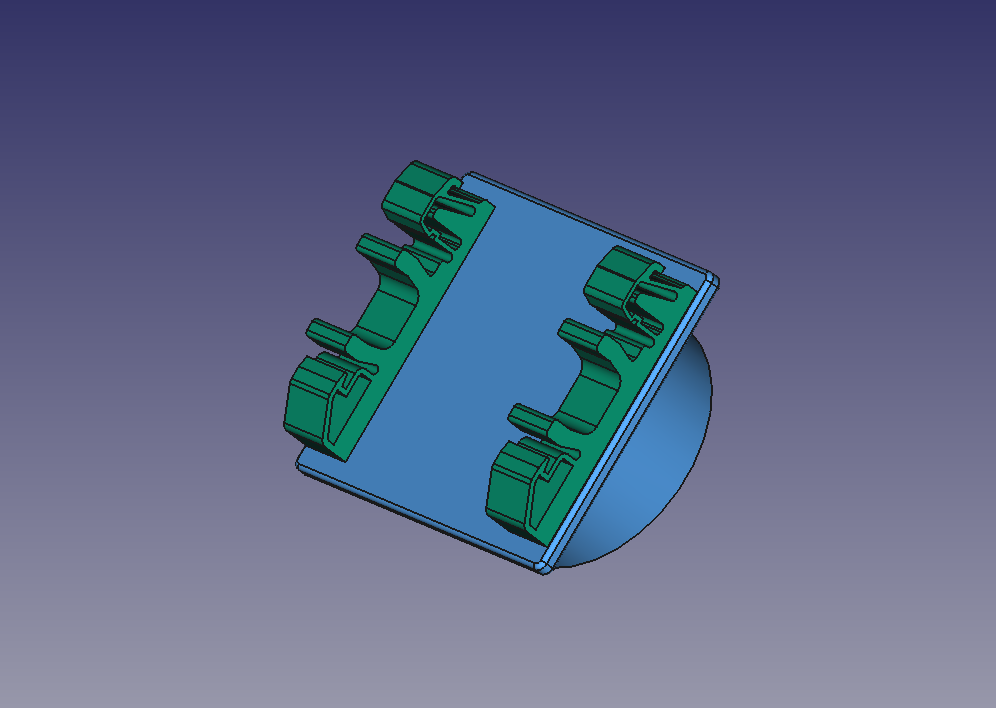The hardware and the included software of this project create a bridge between a Raymarine SeaTalk1 instrument and NMEA. The NMEA sentences generated are sent via a WiFi connection to a remote client. This connection can be directly used with chart plotters such as OpenCPN.
The advantages of this solution are:
- Allows older instrumentation using SeaTalk1 to be connected to newer chartplotters receiving NMEA sentences via WiFI
- The WiFi link allows the instrumentation to be installed in out-of-the-way location thus freeing space in the navigation area
- The board can be installed very close to the data source and does not require laying out data cables to a chart plotter. All that is needed is a 12 Volt connection to the battery
The hardware is a simple board with pads designed to connect to to a 12V source on one side (typically a switched and fused boat battery) and to a Seatalk connector on the other (see PCB layout pictures) board supplies 12V to power the target instrument so that the only connection needed for the system to work is a single 12V feed from the boat electrical panel.
The hardware board is not fused. It is expected that a 0.1A fast acting fuse be provided on the 12V supply line immediately before the circuit. The 12V feed that powers the circuit should also be fused at the distribution panel or go through an appropriately sized resettable circuit breaker.
During the development of the circuit it was noticed that the Raymarine instrument being used (an ST40 wind instrument) was very sensitive about loading of the SeaTalk serial line. To isolate the SeaTalk data line from the rest of the circuitry Q2 acts as a buffer.
Q2 also inverts the polarity of the signal. The polarity is once again inverted by the receiver integrated into U3, which also provides voltage translation down to 3.3V.
U1 implements a regulator rated to least 2A. An earlier version of this board designed with a linear regulator showed that the regulator tended to overheat, which prompted a redesign using a switching topology.
R12 allows the board to be used as a receive-only serial to WIFI bridge. In order to use this feature, the changes to the schematic are:
| Remove | Install |
|---|---|
| Q1, Q2, R9 | R12 |
Now the center pad can be connected to the TX pin of the RS232 port of a NMEA device and the serial stream of NMEA sentences can be sent out to WIFI.
The board has been designed using KiCad and the fabrication files are provided
in the fab directory.
Board dimensions are 31 mm x 22 mm.
On the right side of the board the pads, from top to bottom, are:
- GND
- 12V (unfused, use a 500mA inline fuse)
These pads are connected to the boat battery. A better installation would require powering this board from the same switched connection that powers the navigation station.
On the left side of the board the pads are meant to be connected to a Raymarine SeaTalk instrument. A SeaTalk1 cable has 3 wires that are color coded and the typical color of the insulating jacket is shown in the list. From top to bottom:
| Function | Jacket Color |
|---|---|
| GND | black or bare wire |
| SeaTalk | yellow |
| +12V | red |
On the top side of the board the pads, from left to right, are:
-
Serial Logger (unmarked on the PCB) This pin is connected to the TX pin of serial port 2 of the ESP12 and -if enabled by the user- emits a pretty print of all the commands handled by the hardware (see Serial Logger)
-
Programming cable RX line (marked with R in the layout). This is connected to the RX pin of serial port 1 of the ESP12 and is primarily used to program the device. Serial port 1 of the ESP12 device is used for both programming the board as well as to receive the SeaTalk sentences from the instrument. During development this means that this pin must be disconnected from the programming cable before resetting the board to prevent interference between the programmer hardware and the SeaTalk instrument. Failure to disconnect this cable during regular use will prevent the SeaTalk sentences from being received by the MCU
-
Programming cable TX line (marked with T in the layout) is connected to the TX pin of the ESP12 and is mainly used during programming. It can also be used to output general purpose debug information but the terminal must be programmed with the same serial parameters used by SeaTalk, which are usually 4800 bauds, 8 bits, Even parity, 1 Stop bit.
Since the board power supply is 3.3V the typical programming is performed with a USB to serial converter connected to pads R, T and GND. If no further software development is expected the programming cable should be disconnected from the board and the pads left unconnected.
The two switches on the left side of the image are only used to program the board when using the serial port. Once the initial firmware image is programmed the OTA facility (see Programming Over the Air) can then be used to reimage the flash memory thus not requiring neither the serial port nor the toggling of the switches.
In order to program the board the RST switch (the top one in the picture) should be pulsed while the BOOT switch is kept pressed. At this point the board is ready for the programmer to write the new software.
The software can be compiled using the Arduino GUI. The only library required is Lennart Henning's ESPTelnet library which is used for the both the Telnet server and the NMEA server.
The software runs a web server that serves a single web page used to configure a few parameters of the bridge. Among other things the page allows setting the output power for the WiFi transmitter, enabling or disabling of the serial and telnet logging windows and the port at which the NMEA server is listening. During the first start the software creates a configuration space in EEPROM and stores a few default parameters. The defaults have been chosen to aid in the debgging of the board during firts installation and can be changed accordingly after full operation has been achieved. The built in defaults are:
- Serial logger enabled
- Telnet logger enabled
- The default primary NMEA port is 3030
- The default NMEA talker is "LR"
- Activity LED enabled
- OTA programming enabled
An example of the web page is shown in the following picture.
The default hostname for the instrument is "wind" and can be changed in the software before programming (see sw/seatalk_wifi.h) or at a later point via the configuration web page.
The bottom of the web page also lists the SeaTalk sentences that are supported by the firmware programmed on the brige.
In order to upgrade the firmware it is convenient to use the "Over the Air" (OTA) facility of the ESP8266. Once enabled by using the checkbox in the web page and once the hardware has been reset, a new hostname is available, which is the device hostname with the "_ota" string appended. For example, if the device hostname is "wind", the OTA programmer will be available at the hostname "wind_ota". Now the Arduino IDE or the appropriate Python script can be used to flash a new image without the need to connect a USB to serial port converter. Once the new firmware has been written the OTA programming can safely be disabled.
In gusty wind conditions the wind angle -and to a lesser extent the speed- returned by the wind instrument are subject to very quick jumps only to then return to prevailing conditions. To filter out some of the noise introduced by these jumps the angle and speed data can be independently processed by a simple moving average filter. When these filters are enabled their lenght can be configured using the web page in the fieldset specific to the wind instrument.
A timestamped pretty print of all the commands handled by the bridge is printed out to the serial logger, connected to Serial1 (for wiring information see Front Side). This is not the actual NMEA data but rather descriptive information of each Seatalk command in the order that it was processed.
In the log -and assuming the coloring is enabled- the command byte is typically printed in blue, the payload in the regular terminal color, the name of the command in green and the arguments in terminal color.
Errors are also logged. In this case the byte that caused the error is shown in red. If any error occurs the entire packet received up until that moment is tossed and the software will start seeking another command to interpret. There are 3 types of errors:
- Unrecognized commands, which are commands with the parity bit set but that are not among those recognized by the software
- Parity violations, where a payload byte was received with the parity bit set
- Framing violations, where one of the payload bytes was received that was not consistent with the command being handled.
In the latter 2 cases the argument column provides information about the offending byte.
The software runs a Telnet server that outputs a pretty print of all the commands received, exactly the same information that can be output on the serial port.
The NMEA sentences are available at the port selected in the settings and can be accessed directly via the communication configuration of chartplotters such as OpenCPN. The software will send NMEA data to either NMEA ports as long as there is a connection.
There is a secondary NMEA server that serves the exact same content as the primary and it can be connected at the primary port number plus one.
The NMEA talker can be selected through the web page configuration. The default talker, written in EEPROM upon first boot, is "LR".
Since the Serial TX line of the programming cable (UART0_TXD in the schematic) is not shared with SeaTalk it is used to send out debug information that is useful during installation. To see the output of this port the terminal should be configured with the same setting as SeaTalk (8 bit, Even parity, 1 Stop bit). The information output shows the content of the configuration EEPROM as well as the output from the connection to a WiFi network.
Wind speed and direction can be optionally sent to SignalK via a UDP connection. In the case of the wind instrument the following keys, in the form of serialized JSON objects, are forwarded to SignalK:
environment/wind/angleApparent
environment/wind/speedApparent
The source for these keys is set by the firmware to be Raymarine ST40 Wind.
To read these keys SignalK must be set to receive a UDP connection from the seatalk_wifi device. The IP address and port of the SignalK server can be programmed into the seatlk_wifi device via the Configuration Web Page.
In the case in which a connection to a display unit (e.g. OpenCPN or or SignalK) is not available wind information can be read by means of a pair of gauges available at the URL http://wind/gauges. This is useful in the case where a cellphone or a pad is the only device available.
The gauges are updated every second with measured wind speed and direction. The data is also accumulated and a temperature encoded histogram is created around the edge of both dials. In this way it is possible to evaluate prevalent wind condition for the past few minutes.
The Javascript implementation for the gauges was written by Mykhailo Stadnyk and it is under a MIT license. The GitHub repository can be found at Canvas Gauges.
The project can be improved in a number of ways.
The only instrument available during development was an ST40 wind instrument and the messages that are emitted by that instrument are the only one currently recognized by the software. The software processes the Seatalk sentences using a state machine and it makes rather trivial job to add code that handles new sentences.
The current release does not allow transmitting of Seatalk sentences because there was no need for it in the only ST40 instrument used for development.
In receive mode, the parity bit is extracted using a technique that involves checking for RX errors and then assuming that any such error is due to parity violation (this is required by the way errors are handled in the serial library of the ESP8266 device), but when sending data the parity bit has to be handled as a 9th bit independent of the others which makes it impossible to use the hardware serial port TX pin to do this. When configured to use serial parity the ESP8266 core sets parity based on the bit pattern to send and does not allow independently setting the value of the parity bit. For this reason the SeaTalk TX line is connected to a GPIO in the expectation that a the TX signal can be bit-banged out of it.
Since SeaTalk is a multiple access protocol the ability to transmit sentences requires the need to detect possible interfence from other instruments trying to talk over each other. Since the SeaTalk line is a single one, the transmitted data is also received back by the bridge, which can compare it with the data transmitted to detect collisions.
With the NMEA data now sent via WiFI the ST40 device can optionally be installed in a more secluded place, clearing up some space in the navigation station. A 3D printed mount allows installing the bridge PCB behind the instrument itself and holding the instrument in place with an M3x8 pinch cap screw.
The board is hidden underneath a lid, secured with 2 M2x6 screws, with power supply wires entering from the bottom and wires to the instrument coming out from the top.
Original FreeCAD file and STEP files are provided in the holder
directory.
The mounting holes for the holder are 25 mm apart and are spaced to optionally connect to a DIN rail clip using 3 mm flathead countersunk screws.




